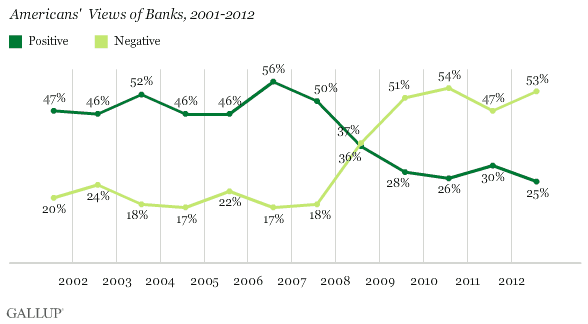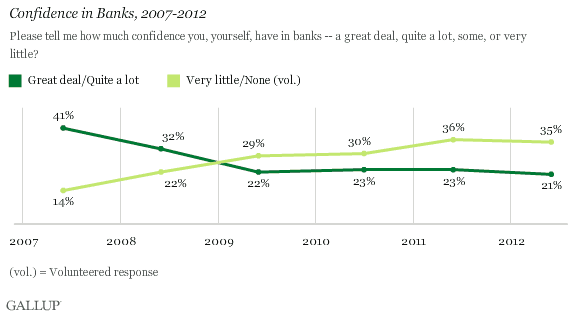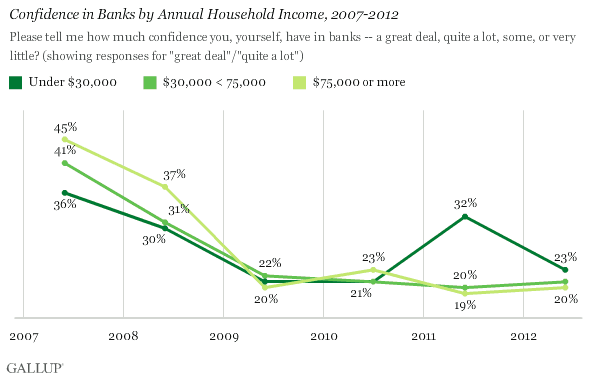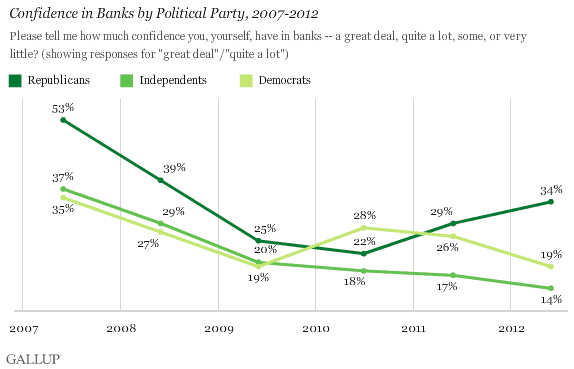One of the reasons given for the slow economic recovery of the past four years is the unusual nature of the economic downturn of 2007-2009. Unlike other post-Depression downturns, this one resulted from the combination of economic recession and financial crisis. Getting the economy going again after such an unusual economic event requires more than just addressing the recession; it also involves fixing the financial system.
Unfortunately, this has not happened. While banks have fortified their balance sheets, many politicians and interest groups have villainized the banking industry. After four years, banking's image is at new lows, and the traditional banking model is being challenged by new rules and regulations.
Yet the U.S. economy cannot return to strong economic growth without a strong and profitable banking system that has a positive image among Americans. Restoring the banking system needs to be a top priority of whoever is elected in November.
Fewer Americans have a positive view of banks
One in four Americans have a positive view of U.S. banks, while half have a negative view. This matches the lowest ratings for the banking business since Gallup began annually polling Americans about the image of 25 business and industry sectors in 2001.
In 2001, the gap between Americans' positive and negative perceptions of U.S. banks stood at +27 percentage points. This changed dramatically with the onset of the 2007-2009 financial crisis, and by 2010, the gap had worsened to -28. It improved to -17 in 2011 before falling back in 2012 to match its worst gap of -28.
The image of the U.S. banking business now ranks third from the bottom out of the 25 business and industry sectors tested by Gallup; only the federal government and the oil and gas industry rank lower. The five-point decline in image rating for banks tied for the largest drop of any industry between 2011 and 2012.

Fewer Americans have confidence in banks
For the fourth year in a row, more Americans have little or no confidence in banks than have a great deal or quite a lot of confidence. Prior to the recession and financial crisis, more Americans consistently said they had a great deal or quite a lot confidence in U.S. banks than said they had little or no confidence. The gap between Americans' positive and negative perceptions now stands at -14 percentage points, the largest since the financial crisis began in 2007.
Americans' confidence in U.S. banks fell to a new record annual low of 21% in June 2012. The percentage of Americans saying they have a great deal or quite a lot of confidence in U.S. banks is now at about half the pre-financial-crisis level of 41% in June 2007.

In the past, upper-income Americans tended to show greater confidence in banks than their middle- and lower-income counterparts. In part, this may be a result of their increased likelihood to visit and interact with bank employees. It also may reflect to some extent the greater fees and charges that middle- and lower-income consumers often encounter. Regardless, Americans of all income levels currently hold about the same low confidence in the nation's banks.

Republicans tend to show greater confidence in banks than do either Democrats or independents. In part, this may be due to Republicans' tendency to have higher income and to be more involved in business, making them more likely to visit and interact with bank employees. It also may reflect to some extent the way Democratic politicians have tended to blame Wall Street and banks for the financial crisis compared with their Republican counterparts. As a result, it may not be surprising that Republican confidence in banks remains higher than confidence among Democrats or independents in 2012.

What executives should do
Borrowing and lending are essential to the U.S. economy functioning. A strong banking business allows consumers and businesses to optimize their credit use and maximize economic growth. A weak banking system does just the reverse, as is currently the case in Europe. As a result, fixing the U.S. banking system, including the ongoing problems in housing finance, should be a top national priority following the presidential election, along with efforts to deal with the so-called fiscal cliff.
Recreating a strong U.S. banking system requires more than banks having strong net worth. It requires Americans to have a strong, positive image of the banking industry -- and now, that does not exist. However, everyone who understands how the U.S. economy works should recognize that fixing the banking system is in their self-interest -- not just in the interest of the banking business. Not everyone agrees about the best way to fix the banking system, but no one should doubt the need for strong and profitable banks if the U.S. economy is going to return to its real growth potential.
In part 2, Dr. Jacobe will share his insights on actions to restore the U.S. banking industry.
